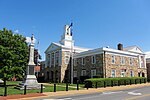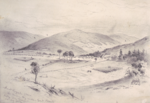Criser High School
1959 establishments in Virginia1966 disestablishments in VirginiaDefunct schools in VirginiaEducational institutions disestablished in 1966Educational institutions established in 1959 ... and 2 more
Historically segregated African-American schools in VirginiaSchools in Warren County, Virginia
Criser High School was an African American school accommodating grades 1–12 constructed in 1959 in the town of Front Royal, Virginia. Its opening occurred the same year 22 African American students integrated the all-white Warren County High School, which drew national media attention.
Excerpt from the Wikipedia article Criser High School (License: CC BY-SA 3.0, Authors).Criser High School
Beeden Lane,
Geographical coordinates (GPS) Address Nearby Places Show on map
Geographical coordinates (GPS)
| Latitude | Longitude |
|---|---|
| N 38.9076 ° | E -78.1909 ° |
Address
Ressie Jeffries Elementary School
Beeden Lane
22630
Virginia, United States
Open on Google Maps








